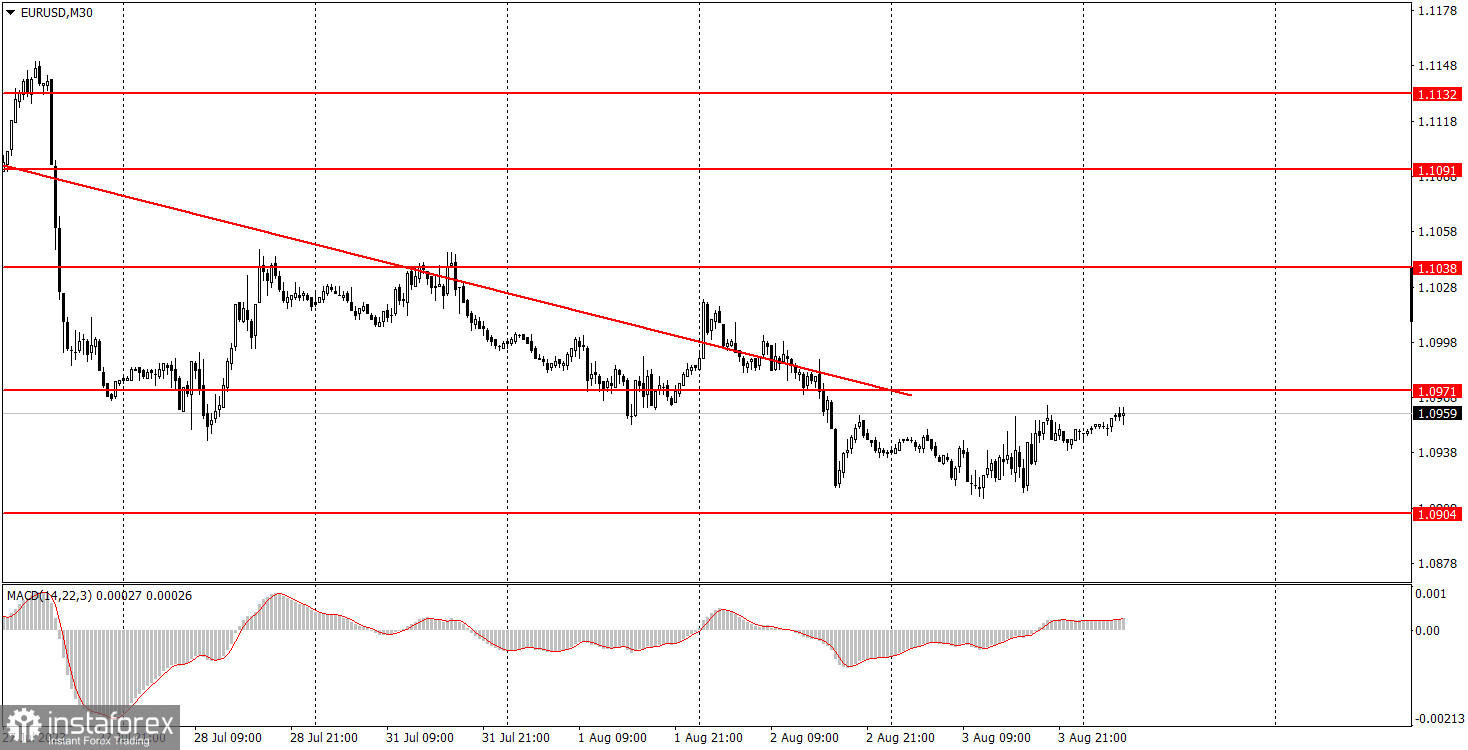Analyzing Thursday's trades:
EUR/USD on 30M chart

The EUR/USD pair went through low volatility on Thursday, with only a 50-point movement. There were several secondary reports, one important report, and also the Bank of England meeting, which indirectly could have influenced the euro. However, all we saw was a 50-point movement. The euro tried to start a bullish correction, but a 50-point movement cannot be considered a correction or a rebound. The PMIs in the European Union cannot be considered significant as they were the second estimates for July. The ISM Business Activity Index in the US service sector fell within the forecast range and stayed above the 50.0 threshold.
Therefore, the downtrend persists, and we can expect the pair to fall further. One more day left for the macroeconomic backdrop to strongly affect market sentiment, but overall, we are disappointed with the pair's movements. Considering the strength and significance of the reports over the past four days, the movements could have been more pronounced.
EUR/USD on 5M chart

No significant patterns were formed on the 5-minute chart. Naturally, the issue was related to the low volatility. However, if you look at how the pair moved throughout the day, even though it covered a range of just 50 pips from the low to the high, it constantly reversed and retraced, with no clear direction. Thus, if there were any significant levels in the pair's path, there would have been numerous false signals.
Trading tips on Friday:
On the 30M chart, the pair extends its downward movement, which is quite logical and justified both in the local sense and in the global context. Currently, the euro is getting rid of its overbought condition, and the market is doubting the perpetual interest rate hikes of the European Central Bank. The key levels on the 5M chart are 1.0835, 1.0871, 1.0901-1.0904, 1.0971-1.0977, 1.1038, 1.1091, 1.1132-1.1145, 1.1184, 1.1241, 1.1279-1.1292. A stop loss can be set at a breakeven point as soon as the price moves 15 pips in the right direction. On Friday, the EU will publish a report on retail sales, and the US will release important reports on unemployment and Non-Farm Payrolls. We expect strong volatility and trending movement again, but this week, the pair has shown a rather sluggish desire to move actively.
Basic trading rules:
1) The strength of the signal depends on the time period during which the signal was formed (a rebound or a break). The shorter this period, the stronger the signal.
2) If two or more trades were opened at some level following false signals, i.e. those signals that did not lead the price to Take Profit level or the nearest target levels, then any consequent signals near this level should be ignored.
3) During the flat trend, any currency pair may form a lot of false signals or do not produce any signals at all. In any case, the flat trend is not the best condition for trading.
4) Trades are opened in the time period between the beginning of the European session and until the middle of the American one when all deals should be closed manually.
5) We can pay attention to the MACD signals in the 30M time frame only if there is good volatility and a definite trend confirmed by a trend line or a trend channel.
6) If two key levels are too close to each other (about 5-15 pips), then this is a support or resistance area.
How to read charts:
Support and Resistance price levels can serve as targets when buying or selling. You can place Take Profit levels near them.
Red lines are channels or trend lines that display the current trend and show which direction is better to trade.
MACD indicator (14,22,3) is a histogram and a signal line showing when it is better to enter the market when they cross. This indicator is better to be used in combination with trend channels or trend lines.
Important speeches and reports that are always reflected in the economic calendars can greatly influence the movement of a currency pair. Therefore, during such events, it is recommended to trade as carefully as possible or exit the market in order to avoid a sharp price reversal against the previous movement.
Beginners should remember that every trade cannot be profitable. The development of a reliable strategy and money management are the key to success in trading over a long period of time.





















